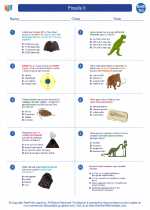Deserts
Deserts are dry, barren areas of land where little precipitation occurs and consequently living conditions are hostile for plant and animal life. They cover approximately one-fifth of the Earth's land surface and can be found on every continent. Deserts can be classified into four main types: subtropical deserts, cold deserts, coastal deserts, and rain shadow deserts.
Subtropical Deserts
Subtropical deserts are the most common type of desert, characterized by high temperatures during the day and low temperatures at night. The Sahara Desert in Africa and the Sonoran Desert in the United States are examples of subtropical deserts.
Cold Deserts
Cold deserts are characterized by low temperatures, especially during the winter, and can be found in the Arctic, Antarctic, and other high-latitude areas. The Gobi Desert in Asia and the Great Basin Desert in the United States are examples of cold deserts.
Coastal Deserts
Coastal deserts are located along the western edges of continents and are influenced by cold ocean currents. These deserts often have dense fog and relatively low temperatures. The Atacama Desert in South America and the Namib Desert in Africa are examples of coastal deserts.
Rain Shadow Deserts
Rain shadow deserts are formed when moist air masses are forced to rise over a mountain range, causing the air to cool and release most of its moisture as rain or snow on the windward side of the mountains. As the air descends on the leeward side, it becomes warmer and drier, creating desert conditions. The Mojave Desert in the United States and the Patagonian Desert in South America are examples of rain shadow deserts.
Study Guide
- What are the main types of deserts? Explain each type.
- What percentage of the Earth's land surface is covered by deserts?
- Give an example of a subtropical desert, a cold desert, a coastal desert, and a rain shadow desert.
- How do rain shadow deserts form?
- What are some of the challenges faced by plants and animals in desert environments?
- What are some of the adaptations that plants and animals in deserts have developed to survive in these harsh environments?
By studying deserts, we can gain a better understanding of the diverse ecosystems on Earth and the unique adaptations that enable life to thrive in even the most extreme conditions.



